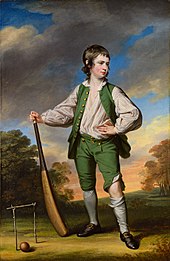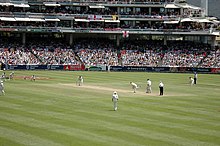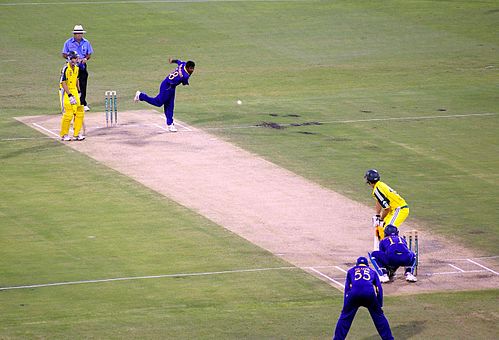Sunday, 14 May 2017
Friday, 12 May 2017
other types of cricket
Other types of matches
Main article: Forms of cricket
There are numerous variations of the sport played throughout the world that include indoor cricket, French cricket, beach cricket, Kwik cricket and all sorts of card games and board games that have been inspired by cricket. In these variants, the rules are often changed to make the game playable with limited resources or to render it more convenient and enjoyable for the participants.
Indoor Cricket was first invented in 1970.[40] It is similar to outdoor cricket except that is played in an indoor sports hall with 6 players per team. It is extremely popular in the UK with national championships and multiple independent leagues. Another less formal version of indoor cricket is played in a smaller arena with a soft ball and without pads was invented some years later and is commonly played in the Southern Hemisphere, and even has its own nominal international championships, including World Cups.
In the UK, garden cricket is a popular version of the sport, played in gardens and on recreation grounds around the country by adults and children alike. Although a cricket bat and ball are generally used, other equipment such as pads and gloves are not. The exact rules will vary based on the number of participants and the available space.
Families and teenagers play backyard cricket or tennis ball cricket in suburban yards or driveways, and the cities of India and Pakistan play host to countless games of "Gully Cricket" or "tape ball" in their long narrow streets. Sometimes the rules are improvised: e.g. it may be agreed that fielders can catch the ball with one hand after one bounce and claim a wicket; or if only a few people are available then everyone may field while the players take it in turns to bat and bowl. Tennis balls and homemade bats are often used, and a variety of objects may serve as wickets: for example, the batter's legs as in French cricket, which did not in fact originate in France, and is usually played by small children.
In Kwik cricket, the bowler does not have to wait for the batsman to be ready before a delivery, leading to a faster, more exhausting game designed to appeal to children, which is often used in physical education lessons at UK schools. Another modification to increase the pace of the game is the "Tip and Run", "Tipity" Run, "Tipsy Run" or "Tippy-Go" rule, in which the batter must run when the ball touches the bat, even if it the contact is unintentional or minor. This rule, seen only in impromptu games, speeds the match up by removing the batsman's right to block the ball.
In Samoa a form of cricket called Kilikiti is played in which hockey stick-shaped bats are used. In original English cricket, the hockey stick shape was replaced by the modern straight bat in the 1760s after bowlers began to pitch the ball instead of rolling or skimming it. In Estonia, teams gather over the winter for the annual Ice Cricket tournament. The game juxtaposes the normal summer pursuit with harsh, wintry conditions. Rules are otherwise similar to those for the six-a-side game.
what is club cricket
Club cricket
Club cricket is a mainly amateur, but still formal, form of the sport of cricket, usually involving teams playing in competitions at weekends or in the evening. There is a great deal of variation in game format although the Laws of Cricket are always observed.
Club cricket is frequently organised in a league or cup format. Games are limited by either time or overs. Limited overs games usually last between 20 and 60 overs per innings. A less common, but more traditional, format is limiting the game by time only. Games can range from a few hours in the evening to two days long. A modern innovation is the introduction of Twenty20 competitions, both as a format in the existing leagues and new leagues solely based on Twenty20, such as LastManStanding.
Standards of play can vary from semi-professional to occasional recreational level and club cricket is often enjoyed as much for the social element as for the competition. Most clubs have their own ground to play on regularly, often including a field and pavilion or club house. An exception being 'Wandering Sides' who use other's grounds.
Many leagues have been formed around the world of varying degrees of professionalism, the oldest being the Birmingham & District Premier League in the Birmingham area of England, founded in 1888.
what is national championship in cricket
National championships
Main article: First-class cricket

Yorkshire County Cricket Club in 1895. The team first became County Championship champions in 1893.
First-class cricket includes Test cricket but the term is generally used to refer to the highest level of domestic cricket in those countries with full ICC membership, although there are exceptions to this. First-class cricket in England is played for the most part by the 18 county clubs which contest the County Championship. The concept of a champion county has existed since the 18th century but the official competition was not established until 1890. The most successful club has been Yorkshire County Cricket Club with 30 official titles.
Australia established its national first-class championship in 1892–93 when the Sheffield Shield was introduced. In Australia, the first-class teams represent the various states. New South Wales has won the maximum number of titles with 45 to 2008.
National championship trophies to be established elsewhere included the Ranji Trophy (India), Plunket Shield (New Zealand), Currie Cup (South Africa) and Shell Shield (West Indies). Some of these competitions have been updated and renamed in recent years.
Domestic limited overs competitions began with England's Gillette Cup knockout in 1963. Countries usually stage seasonal limited overs competitions in both knockout and league format. In recent years, national Twenty20 competitions have been introduced, usually in knockout form though some incorporate mini-leagues.
what is limited over in cricket
Limited overs
Main article: Limited overs cricket
See also: One Day International and Twenty20 International

Sir Viv Richards of the West Indies was voted by Wisden as the greatest One Day International batsman of all time.
Standard limited overs cricket was introduced in England in the 1963 season in the form of a knockout cup contested by the first-class county clubs. In 1969, a national league competition was established. The concept was gradually introduced to the other leading cricket countries and the first limited overs international was played in 1971. In 1975, the first Cricket World Cup took place in England. Limited overs cricket has seen various innovations including the use of multi-coloured kit and floodlit matches using a white ball. A "one day match", named so because each match is scheduled for completion in a single day, is the common form of limited overs cricket played on an international level. In practice, matches sometimes continue on a second day if they have been interrupted or postponed by bad weather. The main objective of a limited overs match is to produce a definite result and so a conventional draw is not possible, but matches can be undecided if the scores are tied or if bad weather prevents a result. Each team plays one innings only and faces a limited number of overs, usually a maximum of 50. The Cricket World Cup is held in one day format and the last World Cup in 2015 was won by the co-hosts, Australia. The next World Cup will be hosted by England and Wales in 2019.
cricket history
Main article: History of cricket
Cricket can definitely be traced back to Tudor times in early 16th-century England though there have been a number of claims, many of them spurious and/or lacking evidence, supporting earlier dates from 1301. The earliest definite reference to cricket being played comes from evidence given at a 1598 court case which mentions that "creckett" (sic) was played on common land in Guildford around 1550. The court in Guildford heard on Monday, 17 January 1597 (Julian date, equating to the year 1598 in the Gregorian calendar) from a 59-year-old coroner, John Derrick, who gave witness that when he was a scholar at the "Free School at Guildford", fifty years earlier, "hee and diverse of his fellows did runne and play [on the common land] at creckett and other plaies."[3][7]

Francis Cotes, The Young Cricketer, 1768
It is believed that cricket was originally a children's game but references in 1611[3] indicate that adults had started playing it and the earliest known organised inter-parish or village cricket match was played around that time.[8] In 1624, a player called Jasper Vinall died after he was struck on the head during a match between two parish teams in Sussex.[9] During the 17th century, numerous references indicate the growth of cricket in the south-east of England. By the end of the century, it had become an organised activity being played for high stakes and it is believed that the first professionals appeared in the years following the Restoration in 1660. A newspaper report survives of "a great cricket match" with eleven players a side that was played for high stakes in Sussex in 1697, and this is the earliest known reference to a cricket match of such importance.[10]
The game underwent major development in the 18th century. Betting played a key part in that development with rich patrons forming their own "select XIs". Cricket was prominent in London as early as 1707 and, in the middle years of the century, large crowds flocked to matches on the Artillery Ground in Finsbury. The single wicket form of the sport attracted huge crowds and wagers to match, its popularity peaking in the 1748 season. Bowling underwent an evolution around 1760 when bowlers began to pitch the ball instead of rolling or skimming it towards the batsman. This caused a revolution in bat design because, to deal with the bouncing ball, it was necessary to introduce the modern straight bat in place of the old "hockey stick" shape. The Hambledon Club was founded in the 1760s and, for the next twenty years until the formation of Marylebone Cricket Club (MCC) and the opening of Lord's Old Ground in 1787, Hambledon was both the game's greatest club and its focal point. MCC quickly became the sport's premier club and the custodian of the Laws of cricket. New Laws introduced in the latter part of the 18th century included the three stump wicket and leg before wicket (lbw).
Thursday, 11 May 2017
what is test match
Test cricket
Main article: Test cricket

A Test match between South Africa and England in January 2005. The men wearing black trousers are the umpires. Teams in Test cricket, first-class cricket and club cricket wear traditional white uniforms and use red cricket balls.
Test cricket is the highest standard of first-class cricket. A Test match is an international fixture between teams representing those countries that are Full Members of the ICC.
Although the term "Test match" was not coined until much later, Test cricket is deemed to have begun with two matches between Australia and England in the 1876–77 Australian season. Subsequently, eight other national teams have achieved Test status: South Africa (1889), West Indies (1928), New Zealand (1929), India (1932), Pakistan (1952), Sri Lanka (1982), Zimbabwe (1992) and Bangladesh (2000). Zimbabwe suspended its Test status in 2006 due to its inability to compete against other Test teams,[37] and returned in 2011.[38]
Welsh players are eligible to play for England, which is in effect an England and Wales team. The West Indies team comprises players from numerous states in the Caribbean, notably Barbados, Guyana, Jamaica, Trinidad & Tobago, the Leeward Islands and the Windward Islands.
cricket rules and game-play
Cricket is a bat and ball game, played between two teams of eleven players each.[12][13] One team bats, attempting to score runs, while the other bowls and fields the ball, attempting to restrict the scoring and dismiss the batsmen. The objective of the game is for a team to score more runs than its opponent. In some forms of cricket, it is also necessary to dismiss the opposition in order to win the match, which would otherwise be drawn.
Format of the game
A cricket match is divided into periods called innings (which ends with "s" in both singular and plural form). It is decided before the match whether the teams will have one innings or two innings each. During an innings one team fields and the other bats. The two teams switch between fielding and batting after each innings. All eleven members of the fielding team take the field, but only two members of the batting team (two batsmen) are on the field at any given time. The order of batsmen is usually announced just before the match, but it can be varied.
A coin toss is held by the team captains (who are also players) just before the match starts: the winner decides whether to bat or field first.
The cricket field is usually circular or oval in shape, with a rectangular pitch at the centre. The edge of the playing field is marked with a boundary, which could be a fence, part of the stands, a rope or a painted line.
At each end of the pitch is a wooden target called a wicket; the two wickets are placed 22 yards (20 m) apart. The pitch is marked with painted lines: a bowling crease in line with the wicket, and a batting or popping crease 1.22 m (4 ft) in front of it. The wicket is made of three vertical stumps supporting two small horizontal bails. A wicket is put down if at least one bail is dislodged, or one stump is knocked down (usually by the ball, but also if the batsman does it with his body, clothing or equipment). This is also described as breaking, knocking down, or hitting the wicket – though if the ball hits the wicket but does not dislodge a bail or stump then it is not considered to be down.
At any instant each batsman "owns" a particular wicket (usually the one closer to him) and, except when actually batting, is safe when he is in his ground. This means that at least one part of his body or bat is touching the ground behind the popping crease. If his wicket is put down while the ball is live and he is out of
| |||||||||||||||||||||||||||
Wednesday, 10 May 2017
what is cricket?
This article is about the sport. For the insect, see Cricket (insect). For other uses, see Cricket (disambiguation).
Tuesday, 9 May 2017
Subscribe to:
Comments (Atom)
-
Cricket is a bat and ball game, played between two teams of eleven players each. [12] [13] One team bats, attempting to score runs, while...
-
subscribe us




